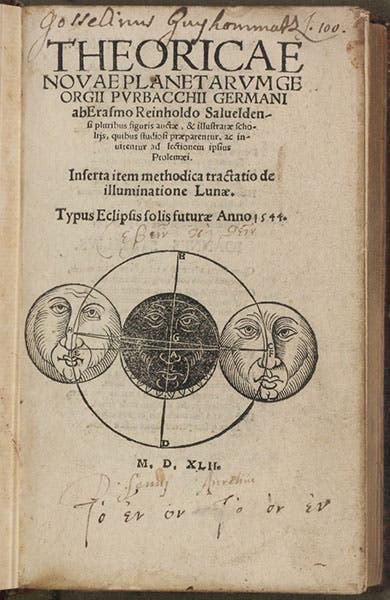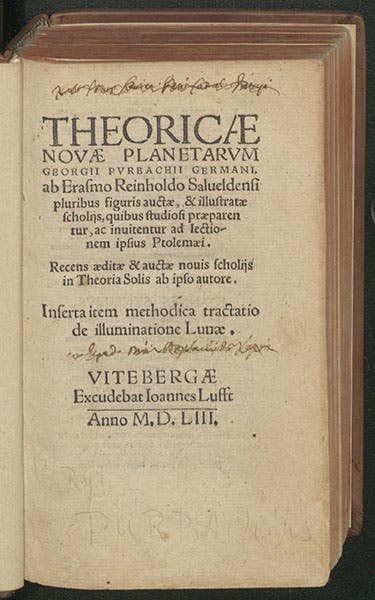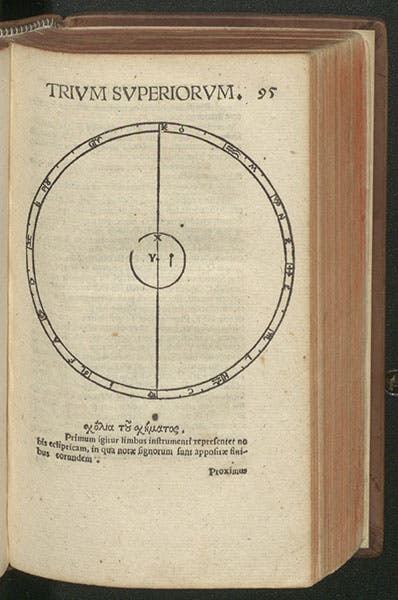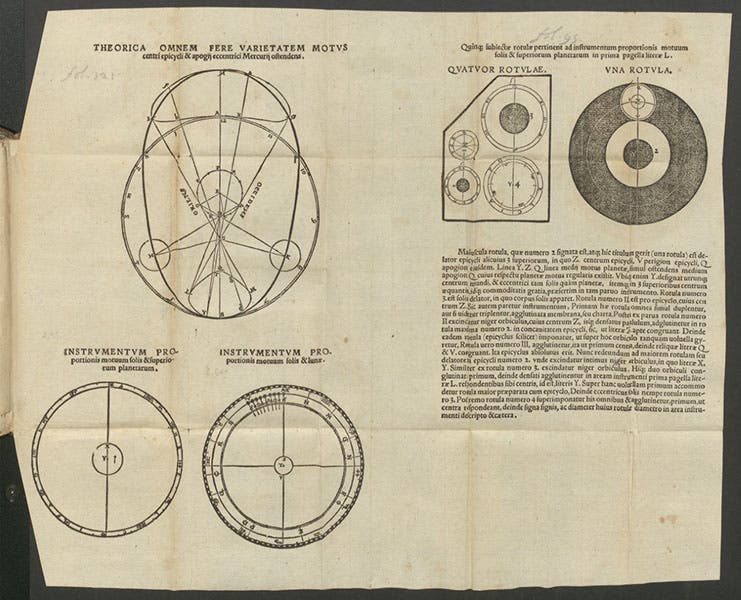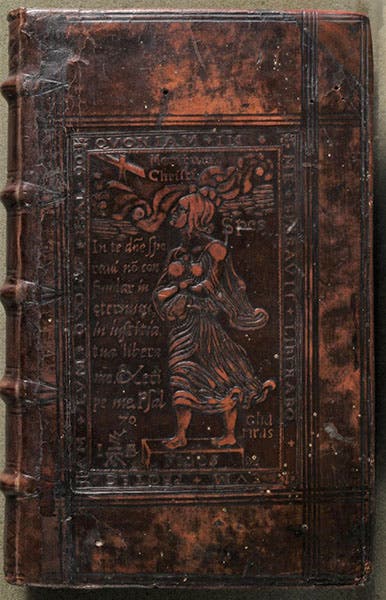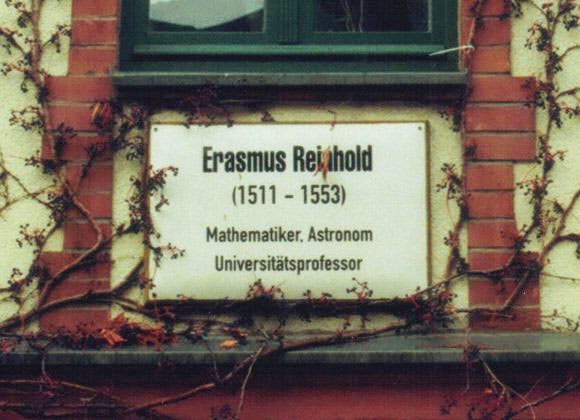Scientist of the Day - Erasmus Reinhold
Erasmus Reinhold, a German astronomer, was born Oct. 22, 1511. He was 6 years old when Martin Luther nailed his 95 theses to the door of Wittenberg Cathedral, a year older when Philip Melanchthon became professor at Wittenberg and the university transformed itself into a bastion of Lutheranism, and probably about 15 when he himself enrolled at Wittenberg, some 125 miles north of his hometown of Saalfeld. Reinhold studied mathematics and astronomy and did so well that, at the age of 24, he was appointed professor of higher mathematics (astronomy) at Wittenberg, one of only four professorships in the entire university. The professor of lower mathematics, i.e., geometry and arithmetic, was Georg Joachim Rheticus, an equally talented young Austrian three years junior to Reinhold. In 1539, Rheticus set off to far-flung Frombork in what is now northern Poland, to learn about a new system of astronomy that had been developed by an aging astronomer, Nicolaus Copernicus, but was not yet in print. Rheticus published a short account of Copernican astronomy in 1540 (the Narratio prima, a book, now very scarce, that we have in our collections), and better yet, encouraged Copernicus to finish his masterwork,
Copernicus did many things in his book: he proposed a new cosmology, with the Sun rather than the Earth at the center of planetary motion, and with the Earth, now a planet, in daily rotation. He also worked out a new set of models with which to calculate the positions of the planets, and these models returned to the principle of uniform circular motion that the ancient astronomer Ptolemy had found it necessary to abandon. The Copernican models were heliocentric, but you could use them to make predictions even if you did not accept the heliocentric hypothesis. The models were not really any more accurate than the Ptolemaic models, but they were easier to use, especially with the aid of trigonometric tables that were entirely missing from older systems of astronomy.
To return to Reinhold: he was a great admirer of Copernicus's book, but he was bothered by the fact that Copernicus arranged some of his data and parameters in the form of tables, but scattered other essential information throughout the text, making it difficult for working astronomers to use. Ptolemaic astronomers were aided in their work by complete systems of tables that had been around for hundreds of years. Called the Alphonsine Tables, they were readily available in printed form in Reinhold's day. Reinhold decided to compile an equivalent system of ready tables using the Copernican models. These were published in 1551 as the Prutenic Tables, named after Albert of Prussia, and they provided the Copernican astronomer with just what he needed to make planetary predictions and calculations. The 1551 edition is very scarce (practical books like this tended to wear out with use), but we have a copy of the second (1561) edition in our collections, as well as a 1585 edition.
Oddly (to us moderns), Reinhold was not a Copernican in the modern sense – he did not believe in a sun-centered universe. But if the hypothesis could produce planetary models that were easier to use, he was all for it, especially if those models returned to the principle that the only motion appropriate for celestial motion is uniform and circular motion. There arose in Wittenberg a small number of like-minded astronomers – mathematicians who used De revolutionibus for its models and rejected the heliocentric hypothesis on which the models were based. The Wittenberg school, as it has been called, with Reinhold at its head, was a first foothold for Copernicanism, keeping Copernican astronomy alive and available until others could take the next step and accept the hypotheses as well.
Reinhold also edited two editions of a classic Renaissance astronomical textbook, the Theoricae novae planetarum of Georg Peurbach. Both of these editions contained volvelles – paper devices that were printed, cut out, assembled, and mounted into a book. Volvelles could be rotated and used as paper instruments. In our copy of Reinhold’s 1542 edition of Peurbach, the volvelles are all properly mounted and completely intact, as we see in our first image, showing the volvelle for the three superior planets (Mars, Jupiter, Saturn). But in our 1553 edition, if you turn to the page that should contain the volvelle (fourth image), it is empty of moving parts – all that is present is what was printed on the page. But if you keep going to the end of the volume, you will find two pages bound in containing uncut volvelles. We show you the sheet that has the parts of the superior planets volvelle (fifth image). The sheet also contains printed directions for assembling the volvelles, directions that were normally discarded. This provides us a unique glimpse into the production of volvelles, especially since we can easily compare the uncut sheets of the 1553 edition to the assembled volvelles in the 1542 edition. These were noticed and brought to our attention by Karl Galle, a library fellow in 2016, who is writing a book on Copernicus in his social and political setting and who has carefully examined all of our 16th-century astronomy texts. More recently, Dr. Galle discovered that the uncut sheet for the superior planets volvelle in our 1553 Peurbach was actually a left-over sheet from the 1542 edition – he could tell because the printed instructions fit the 1542 edition but not the later one. So we actually have two volvelles for the 1542 edition – one properly mounted, and the other unscissored and bound into the 1553 edition. How interesting is that!
Our 1542 edition of Reinhold’s Peurbach is graced by one other attractive feature that we thought we would show you – a beautiful stamped, paneled-calf binding (sixth image). It was made by a bookbinder in Louvain known only as “I.P.”, and many examples survive. It is often called the “Spes” binding, because the word Spes (Hope) is stamped near the head of the figure, with Fides (Faith) and Caritas (Charity) stamped elsewhere, along with a quote from Psalm 70 at the left. I know little about bindings, but it is not hard to admire the care that went into making this one.
There is no known portrait of Reinhold, in spite of examples you might find searching Google Image. He died at a relatively young age, in 1553, only 41 years old. He was possibly a victim of the plague, but we really don’t know. He is commemorated in Wittenberg by a handsome stone plaque, the only Reinhold memorial I am aware of other than his published books (seventh image).
Dr. William B. Ashworth, Jr., Consultant for the History of Science, Linda Hall Library and Associate Professor emeritus, Department of History, University of Missouri-Kansas City. Comments or corrections are welcome; please direct to ashworthw@umkc.edu.


